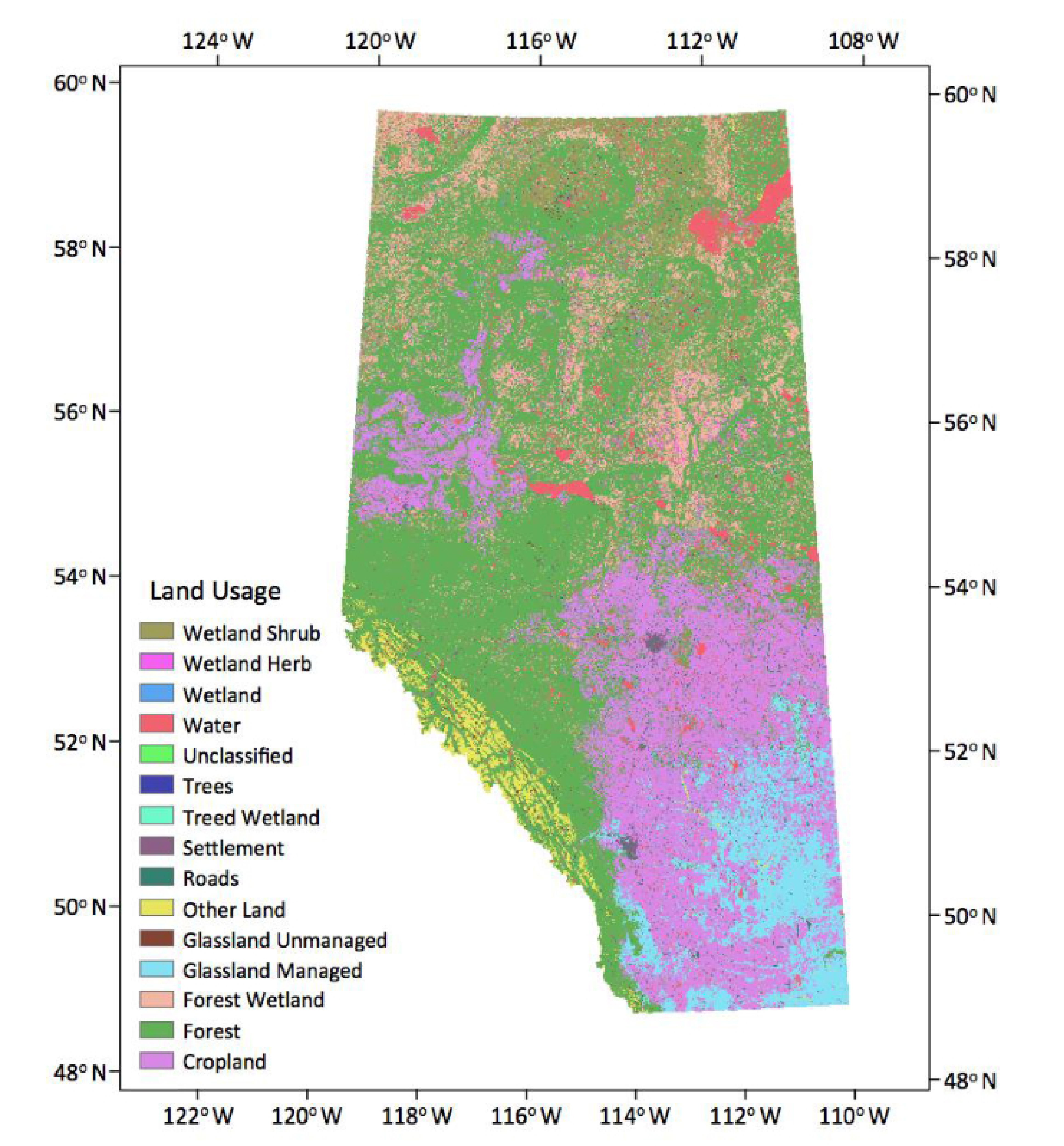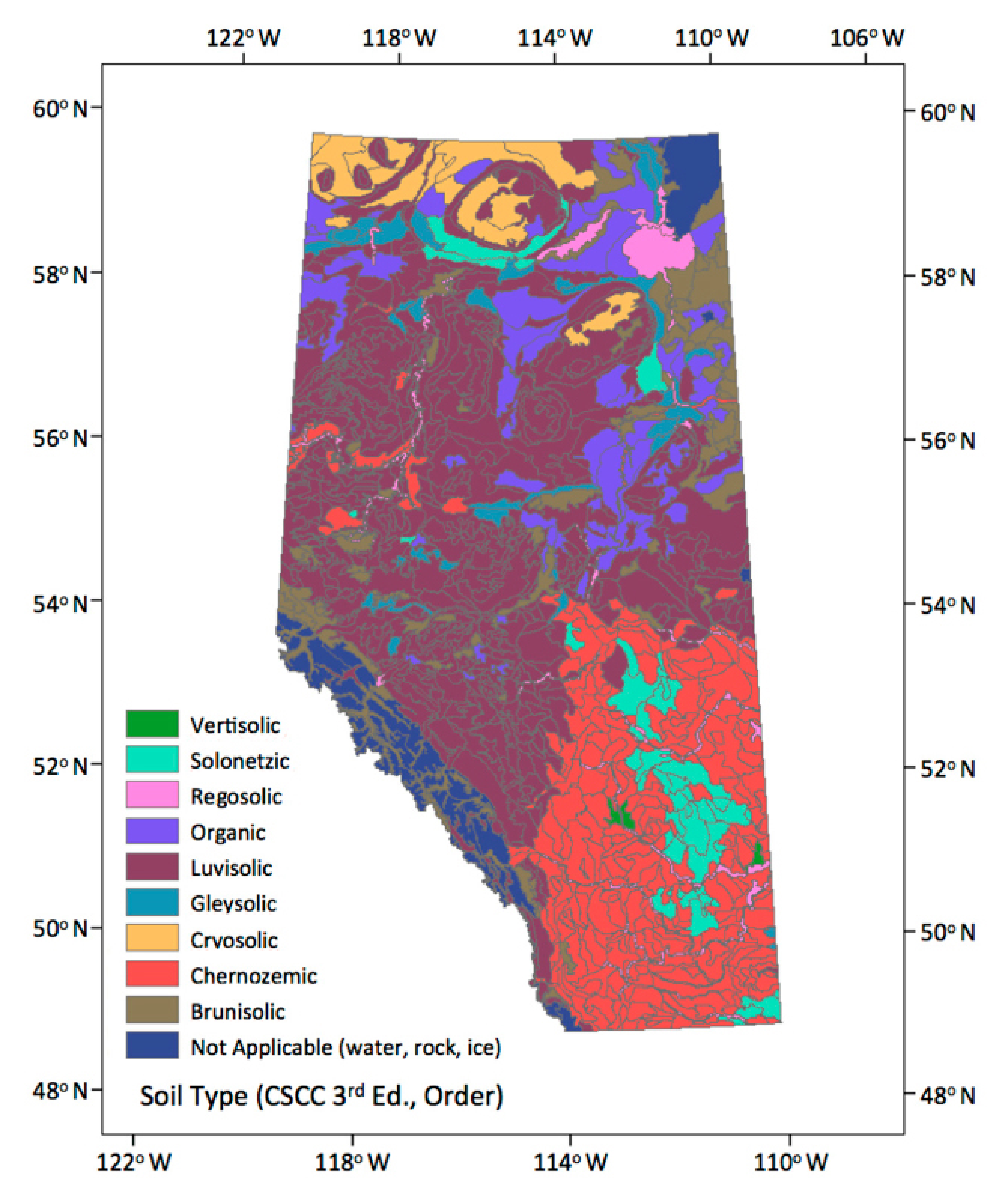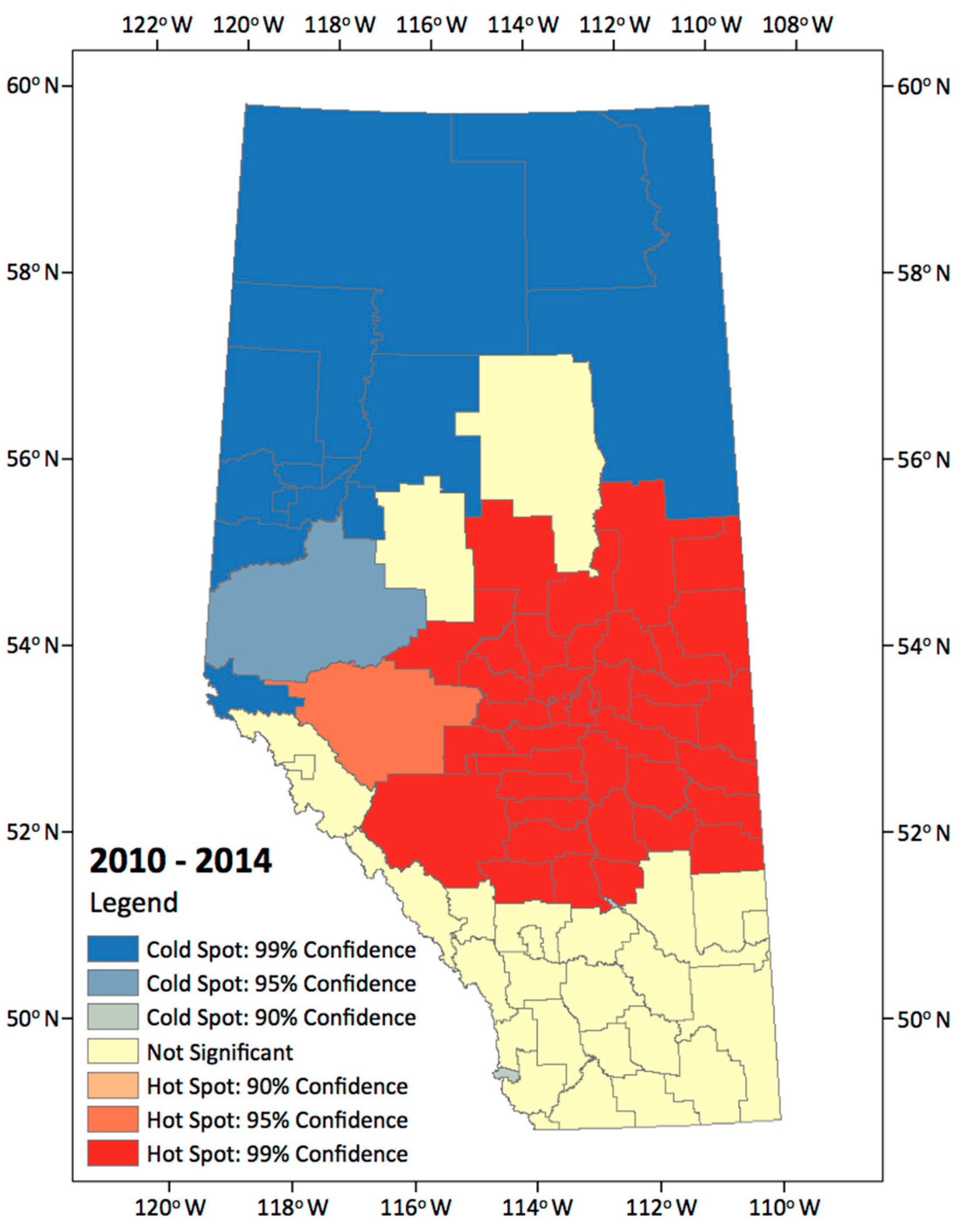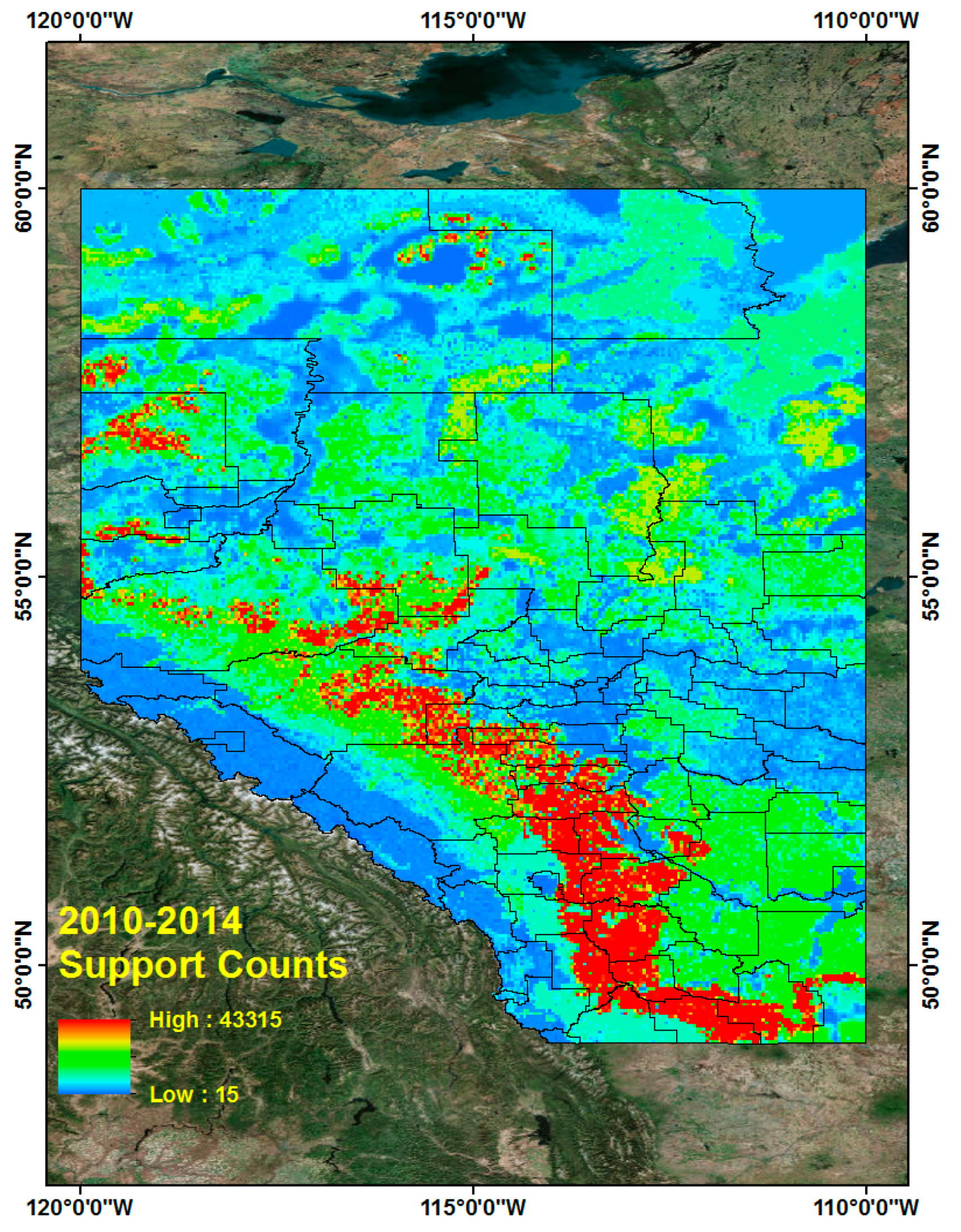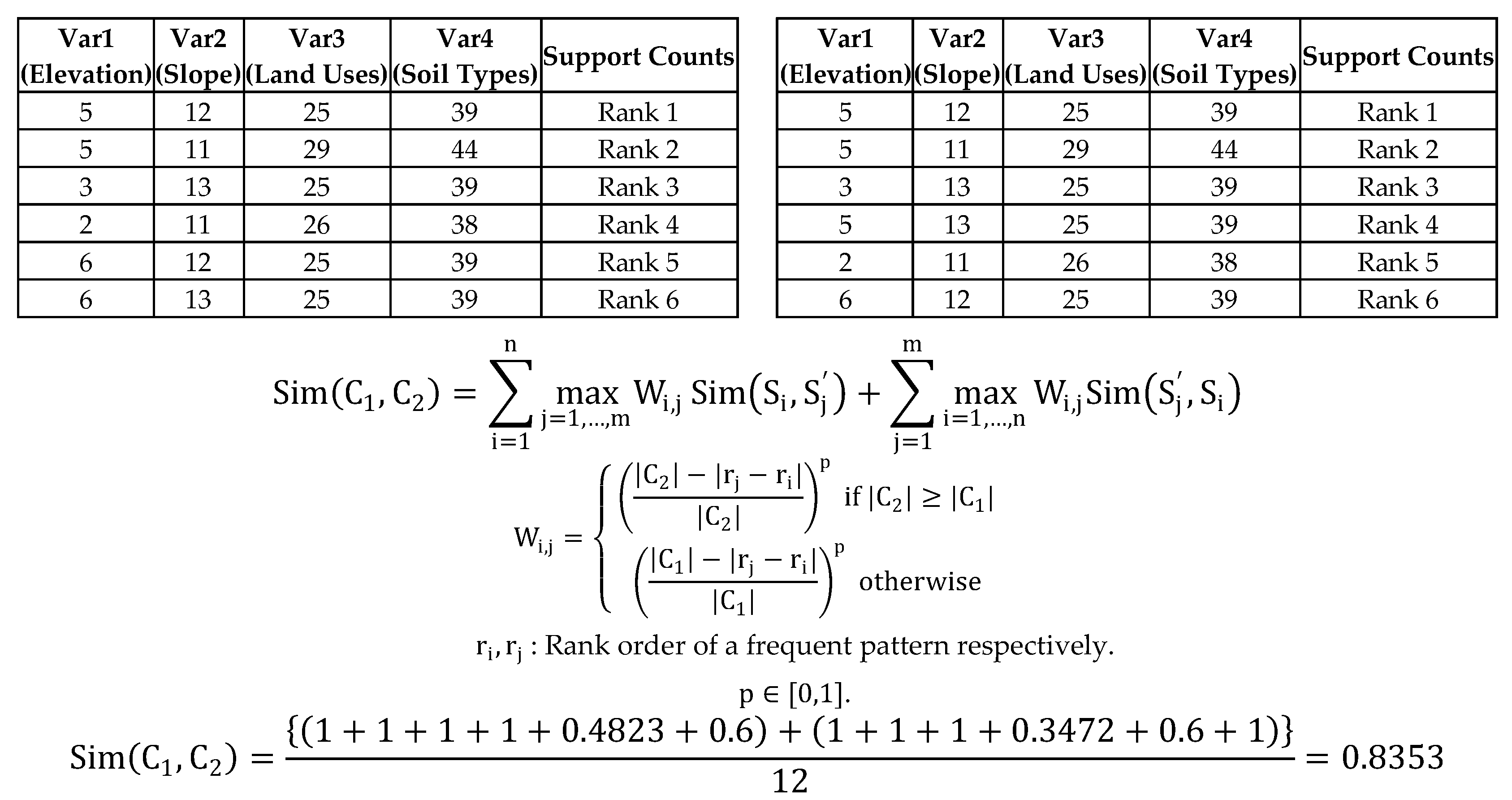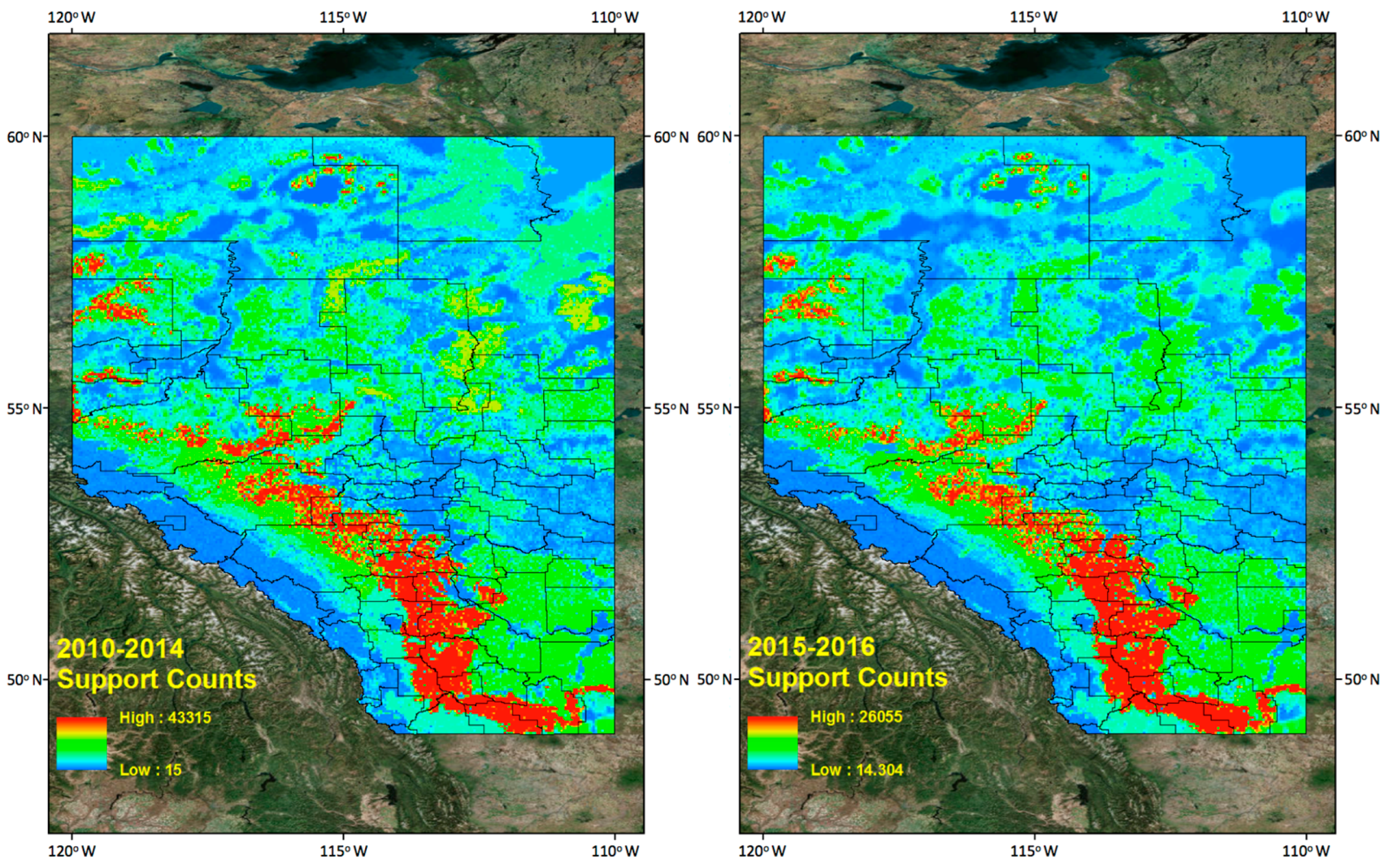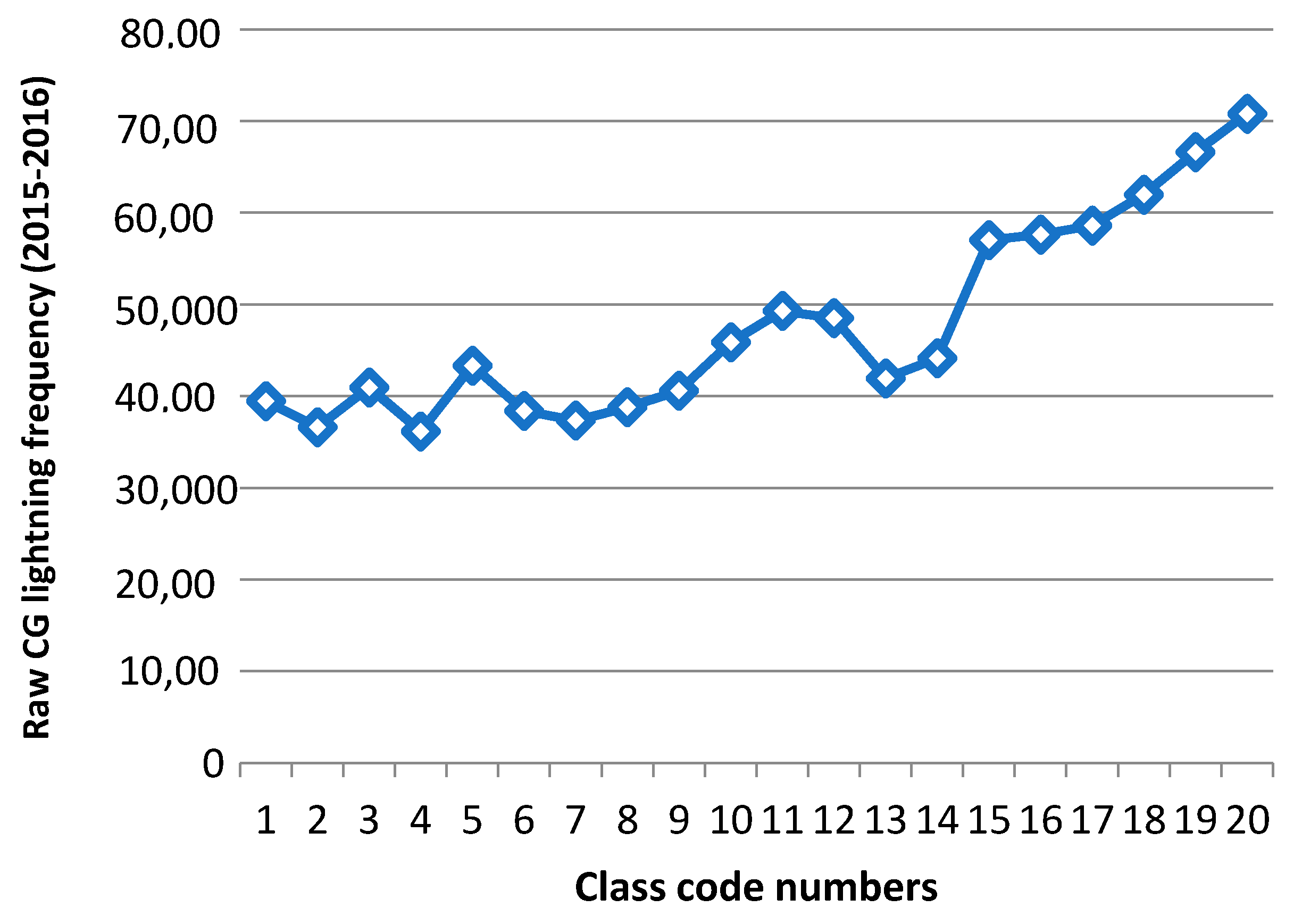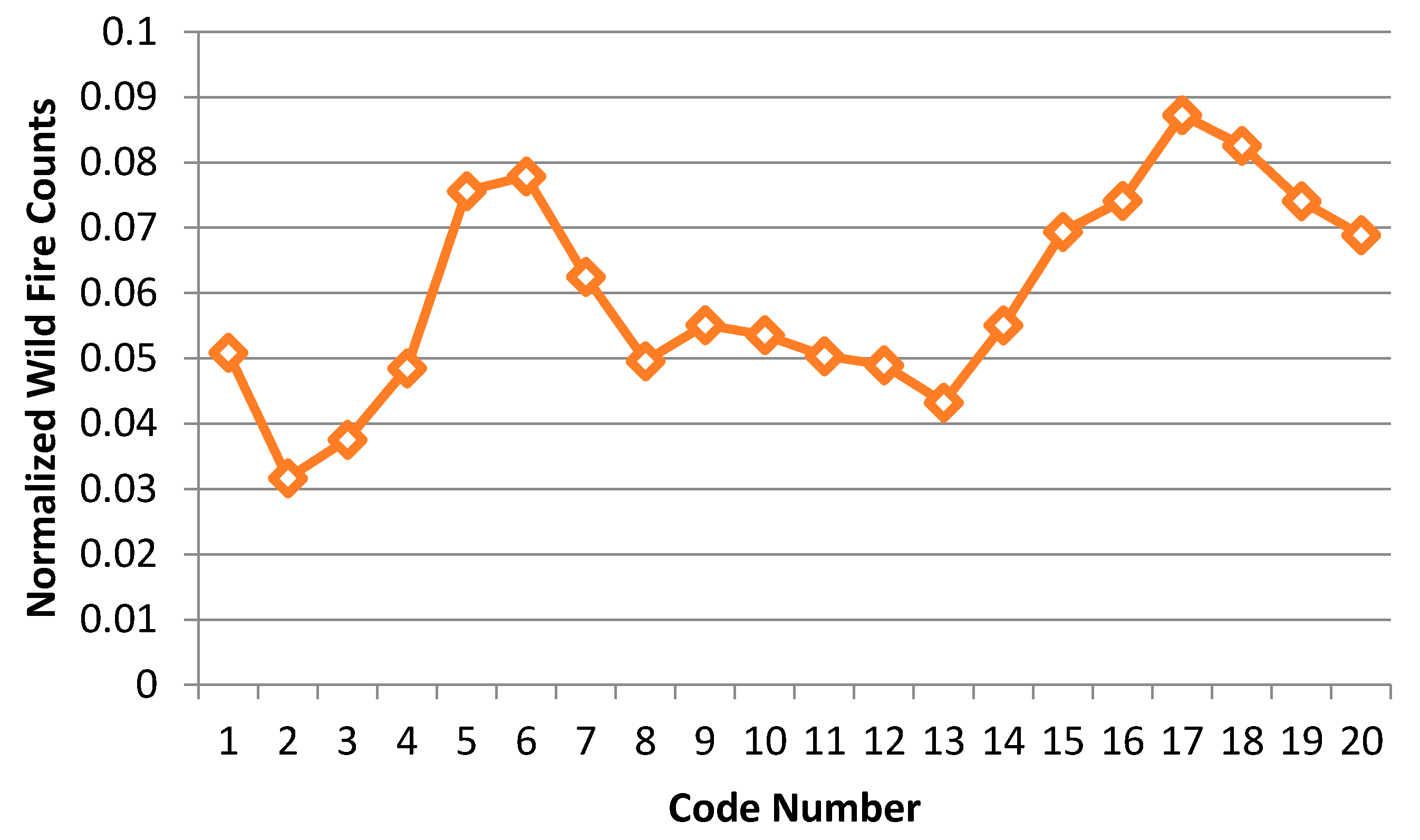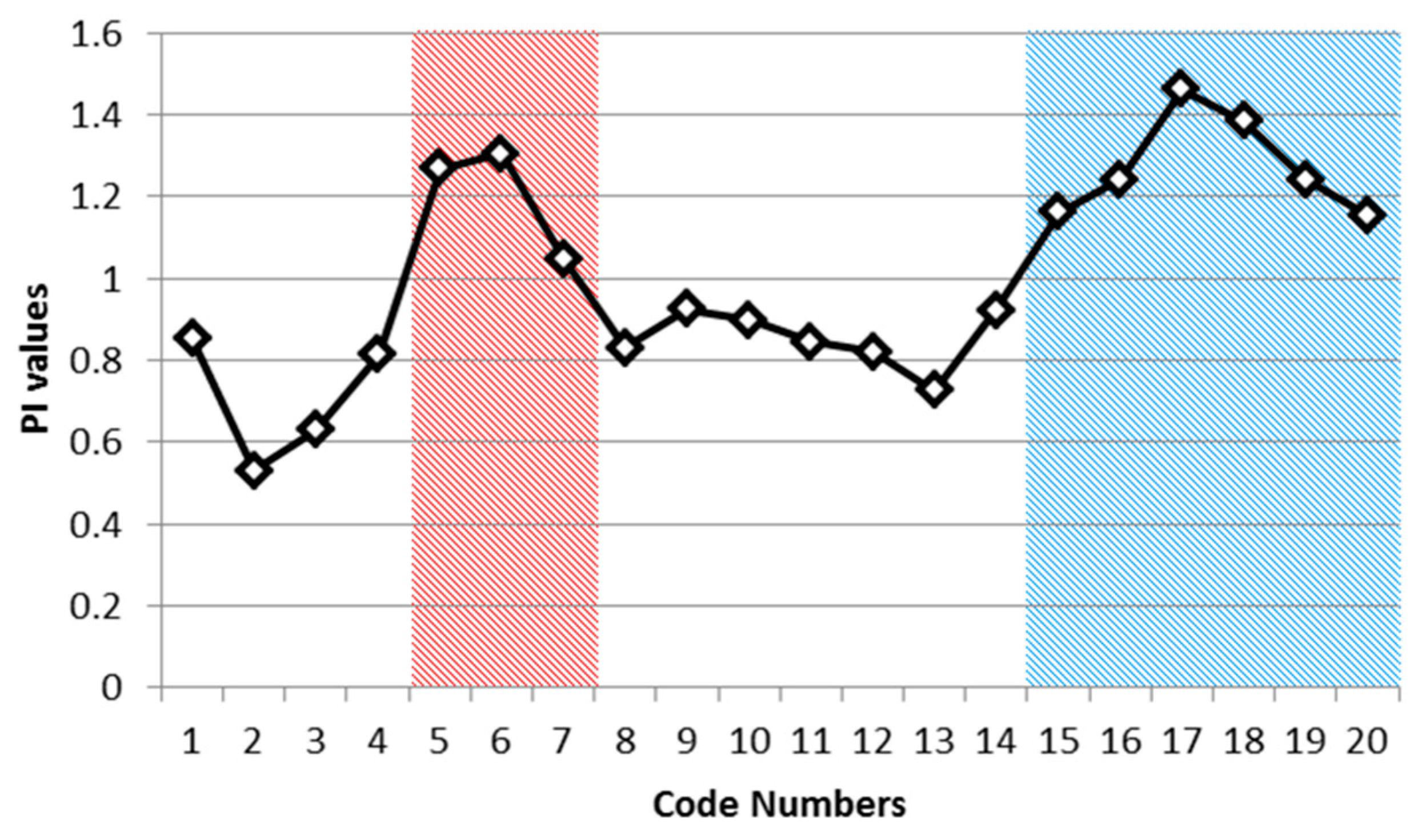6.1. Simiilarity Measure (Consistency Test) for Results
In this section, we measure the similarity between two frequent itemsets results from five years results. Similarity is a quantity that reflects the strength of relationship between two objects or two features. This quantity usually ranges between −1 and +1, or is normalized to between 0 and 1. Distance measures dissimilarity [
49].
If the frequent patterns from the data mining algorithm have a consistency or high similarity throughout the years, we can conclude that the lightning data has specific patterns and these patterns have homogeneity. Our data mining result is multivariate categorical (nominal) data type. For continuous and bivariate data, the notion of similarity is relatively well established, but for categorical data and multivariate data, the similarity computation is not straightforward. For continuous data, the Minkowski Distance is a general method used to compute distance between two continuous multivariate points [
50]. In contrast, we are not measuring a similarity between two individual results for a year; rather, we are measuring the similarity between two different sets. In other words, we need to measure the similarity between two clusters (sets) composed of a discrete (nominal) multivariate data type. There are many criteria in the literature (see [
51,
52,
53,
54]) for comparing two sets or groups with a view to measuring their similarity. However, there are some limitations in that literature. For instance, the literature [
52] may not permit overlapping or joint clusters (sets), or it [
53,
54] may consider measuring similarity for overlapping clusters, but assume that a cluster does not contain duplicates. Given these limitations, the conventional methods in the literature are not applicable to our frequent itemset results. We explain our data type and structure first (
Table 3) and propose an improved method of measuring similarity to overcome these limitations. The variables (Var1~Var4) are independent of each other and describe each land property. As we can see here, there are many joint (overlapping) frequent tuples within each result. For example, in the 2010 results (
Table 3, left), the Elevation property 5 in the first pattern is duplicated in the second. Furthermore, the support count of each frequent pattern implies that there are duplicates. There are more details about the limitations in measuring similarity between two groups in the literature [
52,
53,
54].
To take care of those limitations, we use a Best Match algorithm [
53], which takes as its input the two cluster sets,
(
) and
(
), and a set difference measure. We modify this algorithm by converting support counts into a ranking score to assign a weight value for each frequent pattern. The Best Match algorithm determines how well the frequent patterns reflect each other. Specifically, for each frequent pattern (
)
, we can compute its best representative in
by:
This formula is slightly different from the original Best Match algorithm for finding the minimum of dissimilarity (distances) among all comparable patterns, but this formula (Equation (12)) finds maximum similarity among all comparable patterns. To measure the similarity between two nominal frequent patterns, we used Jaccard’s coefficient, which measures asymmetric information on variables. Since our variables are in the form of categorical (nominal) data, we cannot measure the variable in a quantitative way. We assigned a range of numeric indices to represent each item of variables. This is called consistent labeling. To calculate similarities or distances between two data sets represented by nominal variables, we need to convert these nominal variables into binary dummy variables that have binary values. A binary dummy variable is one that takes the value 0 or 1 to indicate the absence or presence of some categorical effect.
We can calculate the binary distance between the two binary dummy variables using Jaccard’s coefficient (Similarity) formula given by:
where
p is the number of variables that are positive (1) for both objects;
q is the number of variables that are positive (1) for the
object and negative (0) for the
object; and
r is the number of variables that are negative (0) for the
object and positive (1) for the
object.
We compute how well
can be represented by
by summing similarity coefficients from each member of
to its respective best representative in
. We can make this similarity coefficient symmetric by also summing the similarity coefficients from every member of
to its corresponding best representative in
[
53].This gives the final symmetric measure:
We can normalize this similarity using the number of clusters
to make the final similarity score range from 0 to 1. There is one more thing that we need to consider about this similarity measure on our data sets. As we mentioned in the discussion of our data type, we have support counts for each frequent itemset. Therefore, we need to consider these support counts when we measure the similarity; we can do so by assigning weight values according to the support counts. To clarify, here is one example (
Figure 8).
Table 3 is frequent itemset results for each year and they are sorted in descending order based on support counts. If we give rankings by its support count, the data look like below (
Table 4).
The similarity coefficient in
Figure 8 is about 0.9333 but this method ignores the very important information added by the support count for each frequent pattern. The support count of each frequent pattern illustrates how a frequent pattern is more important (frequent) than another within the result itself. The sheer volume of its support count can vary depending on the absolute size of input data. Therefore, when we measure similarity between two clusters, we need to focus on the relative order of priority for each cluster and consider rank differences between the two patterns as a weighting factor. To illustrate a potential influence from these rankings, we will give you an example using
Table 4. When we measure maximum similarity based on
against
∈
, the maximum similarity can be found in
; Their Jaccard’s coefficient value is 1 even if there is a difference of one rank. When there is a rank difference between two comparable frequent patterns, we need to consider how their ranks differ and deduct their similarity coefficient value, which depends on the differences, by assigning a weight factor (
). In this way, the similarity coefficient value of
against
must be less than 1 because there is a difference of rank. In other words, we would only set the similarity number at 1 (maximum similarity value), when each frequent pattern from each cluster is the same and their rank order is the same. Therefore, we contemplate the conformity of each pattern and set a corresponding ranking order. The following formula is the expanded scope of the Best Match algorithm [
53]:
where the weight factor is given by:
: Rank order of a frequent pattern respectively.
.
The weight value is from 0 to 1 and the
p value in the weight factor may be estimated by a decision maker using the weight of the most important criterion.
p = 1 indicates decreasing weight values with same interval and
p = 0 indicates equal weight values. Basically,
p values (0 <
p < 1) make the weight values proportionally decrease as the rank differences increase. For example, when we measure the weight values for two frequent patterns results of
Table 4, the possible rank differences are from 0 to 5 and the number of clusters are six for both
and
. The larger the rank differences between two frequent patterns from each cluster, the smaller the weight values generated; the degree of decrease for the weight values is based on the user-specified
p-value. As
p decreases from 1 to close to 0 (non-zero) in
Figure 9, the weight value slowly decreases as the rank differences increase. If the
p value is 0, this is equivalent with the original Best Match algorithm [
53], ignoring rank differences of the two frequent patterns.
Figure 9 shows the possible weight distribution by different
p-values for
Table 4.
If we calculate the similarity by considering weight values for rank differences based on the Best Match algorithm with
p = 1 for a given example (
Table 4), the similarity measurement result can be calculated as below (
Figure 10).
The Best Match algorithm is modified by assigning weight factors based on rank similarity results in the 0.8694 similarity coefficient value (
Figure 10), which is lower than 0.9333 (Conventional Best Match algorithm,
Figure 8). This is because there are rank dissimilarities between two possible comparison frequent tuples from two clusters respectively. We compute all the similarity coefficient values between two frequent pattern data sets (clusters) throughout five results, from 2010 to 2014, with different
p values (
) that can be chosen by the decision maker. Listed below are the final similarity coefficient results (
Table 5) using the modified Best Match algorithm by assigning weight factors based on rank similarity.
The minimum similarity coefficient value is about 0.85 (85%) and the maximum similarity coefficient value is about 0.95 (95%), with different p values for all possible combinations of two frequent tuple sets of two years. These results that there are high correlations between the two frequent sets results of all possible two year’s results; this means that there are quite consistent similarities or consistent patterns for all years. In other words, there are quite consistent frequent lighting patterns for the four different land properties (i.e., Elevation, Slope, Land Uses, and Soil Types).
6.2. Additional Verification Process by Comparison between 2010–2014 and 2015–2016 Data Mining Results
In the early stages of our research, we had only 2010–2014 CG lightning data and carried out all the related experiments with this data. It is highly desirable that we use the latest dataset (2015–2016) to see whether our experimental results (2010–2014) remain reliable when we compare them to results for the latest dataset. We conducted Association Rule Mining with the more recent dataset to test how consistent these new results are with the old results. We did so by measuring similarity values and comparing the two CG lightning hazard maps from the two different periods (2010–2014 and 2015–2016). Here are the two frequent pattern results, 2010–2014 and 2015–2016 (
Table 6), using Association Rule Mining (CFP-Growth++ algorithm). We also divided the frequent patterns of data mining results into five classes (‘High Risk’, ‘Risk’, ‘Moderate’, ‘Low Risk’ and ‘No Risk’) using the Jenks natural breaks optimization method. We present ‘High risk’ and ‘Risk’ results only.
We recognize that the frequent patterns for 2010–2014 and for 2015–2016 are quite similar. We also measure the similarity coefficient value between these two results to demonstrate that they have a similar quantitative numerical value. The methodology of measuring similarity among Association Rule Mining results is described in
Section 6.1. We measure the similarity by changing parameter
p-values (
p = 1, 0.8, 0.6, 0.4 and 0.2). The similarity results (
Table 7) are described below:
The above results show that there is a very high correlation between the two frequent sets results for 2010–2014 CG lightning and 2015–2016 CG lightning. In other words, there are quite consistent similarities or patterns for all years.
In
Section 6.1, we only measure a similarity value for two individual years, but the combined frequent patterns from 2010 to 2014 and 2015 to 2016 and their two similarity values show much greater similarity than do the individual year’s results. The similarity measurement results between 2010–2014 and 2015–2016 tells us there are quite consistent frequent lighting patterns for the four different land properties (i.e., Elevation, Slope, Land Uses, and Soil Types). In addition, we generated 2010–2014 and 2015–2016 CG lightning hazard maps (
Figure 11) to see if the new 2015–2016 CG lightning hazard areas have spatial distribution of the lightning on four land properties consistent with that of 2010–2014 CG lightning hazard areas. The methodology for generating hazard maps is described in
Section 5.4.
As mentioned before in
Section 5.4, most recognizable high CG lightning risk areas are located in southern Alberta along the east side of the Rocky Mountains. We can find their corresponding land properties and their support counts in frequent pattern results from the data mining results. We find a very similar spatial distribution of the CG lightning hazardous area for the new dataset (2015–2016) when we compare it with the 2010–2014 dataset.
6.3. Comparsion of CG Lightning Hazard Map (2010–2014) with Actual Raw CG Lightning Data (2015–2016)
The CG lightning hazard map for 2010–2014 based on data mining results is divided into 20 classes that occupy the same size of area. The risk values of the map are sorted in ascending order for these 20 classes, where each class has about 5% of the total study area (
Table 8). The hazard map based on the data mining results and the unprocessed raw CG lightning data are independent of each other. What we want to know is whether the higher CG lightning risk classes have more actual CG lightning from 2015 to 2016. In answering this question, we can verify whether the result patterns from data mining techniques are reliable.
Based on our assumptions, the higher the risk level of the class, the greater the count of 2015–2016 lightning data that must appear. The actual CG lightning strikes in each class quantify how many lightning strikes flash within that class.
Table 9 records all relevant data.
Table 9 shows the actual CG lightning distribution (2015–2016) for classes (by class code number) of CG hazard maps (2010–2014) derived from data mining results. If we look at the CG lightning count values in
Table 9, the general trend shows that raw CG lightning counts increased when the hazard map ranges (code numbers) increased. We can check the lightning frequency graph (
Figure 12) of raw CG lightning sorted into classes based on the hazard map results (2010–2014).
We calculated a hazard map based on the data mining results. It consisted of two parts: four different land properties and their supports. We made a continuous CG lightning hazard map over Alberta, Canada based on those mining results. The unprocessed raw CG lightning data’s general frequency trends from 2015 to 2016, classed into the hazard map from 2010 to 2014, increases as the risk classes (class code numbers) increase. This trend is notably more dominant in classes ranging from code number 13 to 20. On the other hand, there are still quite a significant number of CG lightning strikes in lower risk areas. This may suggest some research limitations.
We limited our analysis to the four land properties (i.e., Elevation, Slope, Land Uses, and Soil Types), but there could be many other triggers for lightning flashes on the surface. Despite the limited assumptions we set, the general trends of CG lightning for 2015–2016, classed on the hazard map for 2010–2014, show that higher risk areas on the hazard map have more actual CG lightning. We can also check these patterns by generating a density map of CG lightning. The lightning density map is based on the calculation of a magnitude-per-unit area from the lightning point features that fall within a neighborhood. We used the Point Density tool [
55] in ArcGIS software [
36] to make this density map (
Figure 13 (Right)).
We divided the Province of Alberta into two clusters to look at the regions of high CG lightning density. The first cluster includes higher lightning risk areas (code numbers 17–20), which cover 20% of the total study area (
Figure 13 (Left)), and the second cluster includes lower lightning risk areas (code numbers 1–16), which cover 80% of the total study area. In addition, we can check
Table 9 for the corresponding percentage of the CG lightning counts from 2015 to 2016, which for these two clusters (groups of code numbers) are 26% and 74%, respectively. In
Figure 14, the area marked in white is the same as the high risk (first cluster) regions in
Figure 13 (Left). The contour lines describe a density map of raw CG lightning for 2015–2016. We can see that most high CG lightning density areas are located in the higher risk regions (code numbers 17–20,
Figure 13 (Left)). In conclusion, we can verify by quantitative measurement from
Table 9 and visual interpretation from
Figure 14, that the higher risk areas on the hazard map have the more numerous and more densely occurring CG lightning flashes.
